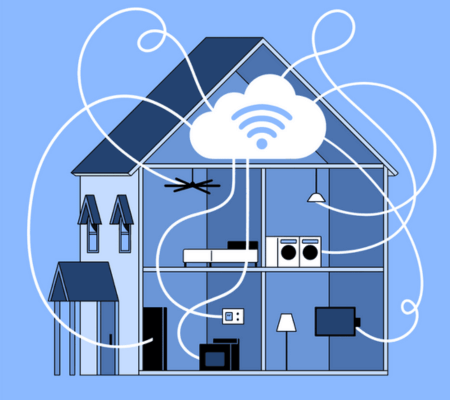Welcome to the world of home automation, where technology meets convenience to simplify your life. In this beginner’s guide, we’ll explore the concept of home automation, its benefits, and how artificial intelligence (AI) plays a crucial role in transforming your living space into a smart and efficient home.
What is Home Automation?
Home Automation, in its simplest form, refers to integrating technology into your household to control and automate various tasks, making your life more comfortable, secure, and energy-efficient. Using a central control system, this technology allows you to remotely manage your home appliances and systems, from lighting and heating to security and entertainment.
Benefits of Home Automation:
- Convenience: Imagine controlling your thermostat, lighting, or music with just a voice command or a tap on your smartphone. Home automation systems offer unparalleled convenience by allowing you to manage your home remotely.
- Energy Efficiency: AI-powered home automation systems can optimize energy usage, lowering utility bills. For example, smart thermostats learn your preferences and adjust the temperature accordingly, saving energy when you’re away.
- Security: With the integration of AI, home security has reached new heights. Surveillance cameras can identify potential threats and send alerts to your smartphone, providing peace of mind and real-time property monitoring.
- Safety: AI-powered sensors can detect smoke, gas leaks, or unusual activity, sending immediate alerts to you or emergency services if necessary, ensuring the safety of your loved ones.
- Entertainment: Home automation systems can transform your living room into a home theater with just a voice command. You can control your smart TV, streaming services, and lighting to create the perfect ambiance for movie night.
- Accessibility: Home automation can be a game-changer for people with mobility challenges. Voice-activated devices and automated controls make it easier for everyone to navigate their living space.
The Role of AI in Home Automation:
Artificial Intelligence is the driving force behind home automation, enabling devices and systems to learn and adapt to your preferences. AI algorithms analyze data from sensors, devices, and user inputs to make intelligent decisions. Here are some ways AI enhances home automation:

- Personalization: AI algorithms can understand your habits and preferences, allowing your smart home to adapt to your daily routines. For instance, it can adjust the lighting and temperature based on your schedule.
- Voice Control: Voice-activated assistants like Amazon Alexa and Google Assistant use AI to understand and respond to your voice commands, making it easy to control your smart home.
- Predictive Maintenance: AI can predict when your appliances or systems need maintenance or repair, preventing unexpected breakdowns.
- Security: AI-powered security cameras can distinguish between a family member and an intruder, reducing false alarms.
- Energy Management: Smart thermostats use AI to analyze your heating and cooling patterns and adjust settings to maximize energy efficiency.
If you’re interested in enhancing the security of your home automation system, check out this article on The Best DIY Home Security Systems.
Home Automation Systems
Home automation refers to the use of technology to control and automate various household tasks and systems, making it more convenient, energy-efficient, and secure. It involves the integration of devices, sensors, and software to create a smart home environment. Here are some key aspects and components of home automation:

- Smart Devices: These physical devices can be controlled remotely or automated. Common examples include smart thermostats, smart lights, smart locks, cameras, speakers, and smart appliances.
- Sensors: Sensors are used to gather data about the environment and conditions in your home. Examples include motion, temperature, humidity, and door/window sensors.
- Control Hub: A central control hub or a home automation controller is used to manage and coordinate the various smart devices in your home. This can be a standalone device, a smartphone app, or a voice-activated assistant like Amazon Alexa or Google Assistant.
- Automation Rules: Home automation systems allow you to create rules or scenarios that trigger specific actions based on predefined conditions. For instance, you can set up a rule that turns off the lights when no motion is detected for a certain period.
- Voice Control: Many home automation systems can be voice-controlled, allowing you to use voice commands to operate devices and execute automation routines.
- Remote Access: With a smartphone app or a web interface, you can control and monitor your smart home devices from anywhere with an internet connection. This is useful for security and convenience.
- Energy Efficiency: Home automation can help reduce energy consumption by optimizing heating, cooling, and lighting systems. For example, you can schedule your thermostat to lower the temperature when you’re not at home.
- Security: Smart security systems can include cameras, doorbell cameras, and sensors that can alert you to potential security threats and allow you to monitor your home remotely.
- Entertainment: Home automation can also be used for entertainment purposes, such as controlling audio and video systems, streaming content, and creating immersive home theater experiences.
- Integration: Many home automation platforms allow for integrating third-party devices and services, creating a comprehensive smart home ecosystem.
- Privacy and Security Concerns: With the increasing connectivity of smart devices, there are concerns about privacy and security. Securing your smart home network and being cautious about sharing personal data with these devices is important.
- Cost: While home automation can provide convenience and energy savings, it can also be an investment. The cost can vary widely depending on the complexity of the system and the number of devices you want to automate.
Overall, home automation offers numerous benefits in convenience, energy efficiency, security, and entertainment. It allows homeowners greater control over their living spaces and can enhance the quality of life in many ways. However, planning and implementing home automation systems carefully is important to ensure they meet your specific needs and preferences.
Three common uses of home automation

1. Convenience
Home automation systems are frequently used to make daily tasks more convenient. For example, you can remotely control lighting, heating, and cooling systems, so you can adjust them to your preferences without getting up from your couch or bed. You can also automate routine tasks, like turning off lights and locking doors when you leave the house.
2. Energy Efficiency
Many homeowners use home automation to save energy and reduce utility bills. Smart thermostats, for instance, can learn your heating and cooling patterns and adjust temperatures accordingly, optimizing energy usage. You can also use automation to turn off lights, appliances, and other devices when they’re not in use.
3. Security and Safety
Home automation can enhance security and safety by integrating smart security cameras, doorbell cameras, motion sensors, and door/window sensors. You can receive alerts and monitor your home remotely, and automation rules can simulate your presence at home when you’re away, deterring potential intruders.
Examples of home automation:
- Smart Thermostats: Devices like the Nest Thermostat can learn your temperature preferences and adjust heating and cooling systems accordingly to save energy.
- Smart Lighting: Smart bulbs or switches allow you to control lighting remotely, set schedules, and create ambiance with different colors and brightness levels.
- Smart Locks: These can be controlled via a smartphone app and can be programmed to grant temporary access to visitors or service providers.
- Voice Assistants: Devices like Amazon Echo and Google Home allow you to control various smart devices using voice commands.
- Home Security Systems: These may include smart cameras, doorbell cameras, motion sensors, and window/door sensors that provide real-time alerts and video feeds.
- Automated Window Blinds: Smart blinds can be programmed to open and close based on the time of day, temperature, or your preferences.
The three levels of home automation can be described as follows:
- Entry Level: At this level, you have basic automation features such as smart lighting, a programmable thermostat, and maybe a smart speaker. These devices can be controlled individually via smartphone apps.
- Intermediate Level: This level involves more integration and automation. You might have a central control hub that connects various devices, allowing you to create automation routines. For example, you can set up “Good Morning” and “Goodnight” routines that adjust lights, temperature, and more with a single command.
- Advanced Level: You have a highly integrated and sophisticated smart home ecosystem at the advanced level. You can create complex automation sequences considering multiple factors like time, occupancy, and environmental conditions. Security and entertainment systems are often part of this level, providing comprehensive control over your home.
Conclusion
Home automation, powered by AI, is revolutionizing the way we live. It offers convenience, energy savings, security, and entertainment at your fingertips. As you embark on your home automation journey, remember that the possibilities are endless, and technology continually evolves. Embrace the future, and enjoy the benefits of a smart, automated home that simplifies your life. Get started today!
Related:










